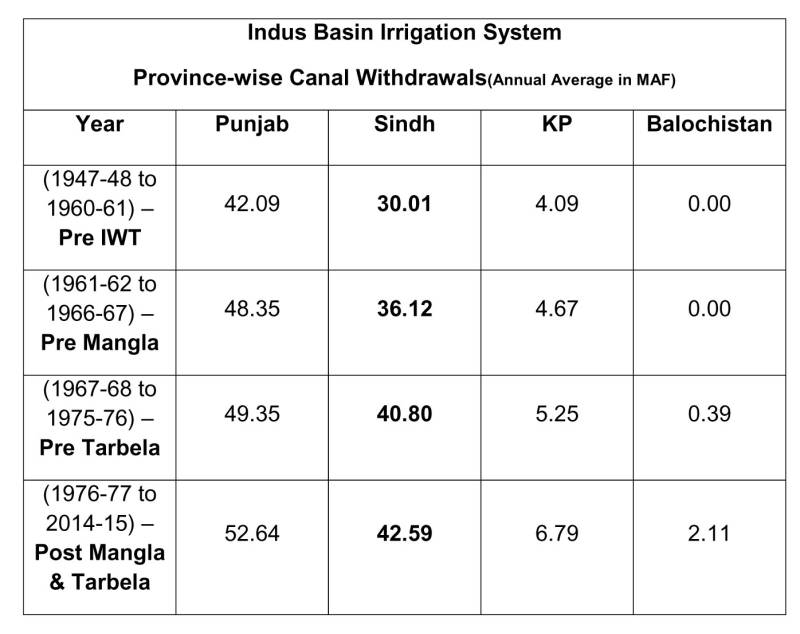Zafar Mahmood (Episode 10) - Another perception which needs to be analyzed is as follows: Chashma-Jhelum (CJ) and Taunsa-Panjnad (TP) Link Canals were not required on River Indus and were built in the name of Indus Basin Replacement Works so that Punjab could steal water from Indus.
The background of Indus Water Treaty was mentioned in detail in previous episodes. Some writers consider that in the Indus Basin Replacement Works (IBRW), the diversion of water from River Indus through CJ Link and TP Link canals was done with a malafide intent.
Out of eight (8) link canals constructed under IBRW, the two link canals, Chashma-Jhelum (CJ) &Taunsa-Panjnad (TP) were to transfer the water from Indus River to Jhelum and Chenab. There is a difference in approach to treat the link canals built to transfer the water between Rivers. Some of the water experts consider these link canals from Indus, a ploy to deprive lower riparians. They would want these link canals to be operated only, after obtaining proper permission of lower riparian.
The water experts of Punjab think that apprehensions about the operation of these canals were created at the time when there was absence of Water Apportionment Accord among Provinces. Such fear carried more plausibility at that time. After the Water Apportionment Accord in 1991, when all provinces are only entitled to their allocated share, IRSA be allowed to operate the system without any veto power by one province.
The crux of the problem relates to the mechanism and timing of storage and release of waters in the link canals than anything else. In order to alley the misgivings of one province, there may be justification to have an agreed SOP on the timings of release of water in these canals, keeping in view the extent of the water flows and the demand pattern in the provinces. Such an SOP may also focus on managing water in shortage years.
Tarbela Dam was not required but Punjab insisted on its construction with the intention to take water from Indus at the expense of lower riparian areas.
In my study of the water storage issue, I have come across writings of some researchers who genuinely believe that Pakistan does not need a dam at Kalabagh or at other site on Indus. In their opinion storage dams are thrust on lower riparians against their wish. In this regard they believe that Punjab insisted on building Tarbela in the Indus Basin Replacement Works although it was not required. Moreover, storage through Mangla Reservoir was enough to meet the shortage caused by the new arrangement created by Indus Water Treaty.
Although this narrative has lost its appeal over the period of time because Sindh has benefitted a lot through increased allocation of water, which would not have been possible if Tarbela was not constructed. However, to put the record straight, it may be mentioned that Tarbela dam was constructed mostly because of the passionate efforts of Ayub Khan. In his book “Friends Not Masters” former President of Pakistan has taken credit for forcefully negotiating with the World Bank for the construction of Tarbela Dam.
Not many people know that KBD site at one point in time was preferred over Tarbela. An evaluation prepared in August 1967 by the World Bank Consultant Mr. Pieter Lieftinck (Water and Power Resources of West Pakistan) mentions that although Tarbela is a more complex dam to build but its feasibility is at a much advanced stage than KBD. That is why it should be started first. Also Ayub Khan was much more keen to build Tarbela Dam probably because of its proximity to his home. Once severe shortage of funds for construction of this dam, compelled a hurricane trip to five Capitals of the Western World to line up the required finances. Ayub Khan himself narrates the account of persuasion he used on the World Bank for construction of Tarbela Dam in following words:
" … and I quote the words as I recall using them: 'I have been around these areas which are going to be affected by the withdrawal of waters by India. People have told me very plainly that if they have to die through thirst and hunger they would prefer to die in battle and they expected me to give them that chance. Our Jawans and the rest of the people feel the same way. So this country is on the point of blowing up if you don't lend a helping hand." (Ayub Khan "Friends not Masters" P 108-110).
Mr. Wahab Shaikh in his “Presentation of Sindh Case before the Indus Water Committee’ also mentions about the priority of constructing Tarbela Dam by Ayub Khan as mentioned below:
“...the President told the Bank that if it does not agree with Tarbela, the Bank should at least take note of it and recognize the necessity of Tarbela being built at an early stage." (Shaikh, A.W.F, Chief Engineer Irrigation, ‘Presentation of Sindh Case before the Indus Water Committee’, Karachi & Lahore, 1971, P.61)
The following table would show the allocation of water to Sindh province before and after construction of Mangla and Tarbela reservoirs:
Some writers residing in the lower riparian areas are generally apprehensive about creation of a storage facility in upstream region. The fear emanates from the possible leverage on storage and downstream releases that it presumably gives to the upper riparians. However, those fears had more justification when there was no water accord among the provinces; which was the case when KBD project became controversial. In the current scenario, the record clearly illustrates the increased supply to Sindh in post Tarbela period. Any further addition in the storage capacity, like it happened in case of Tarbela, would be in the interest of all provinces including Sindh.
(The writer is Wapda chairman and can be reached at chairman@wapda.gov.pk)






